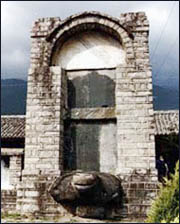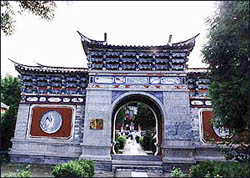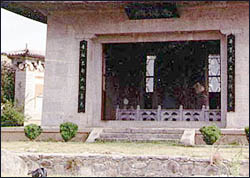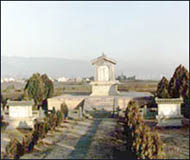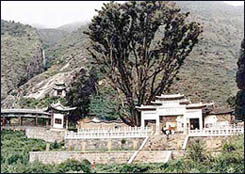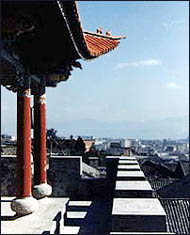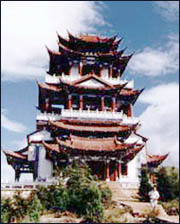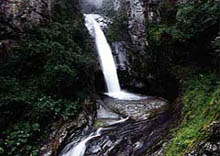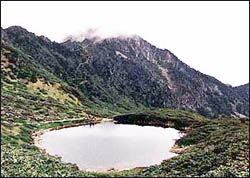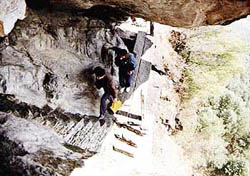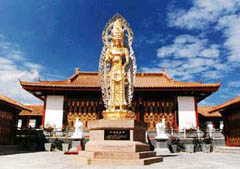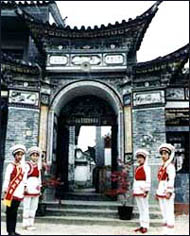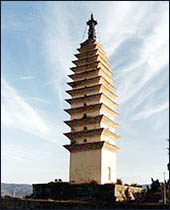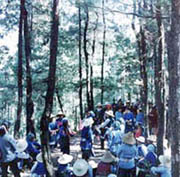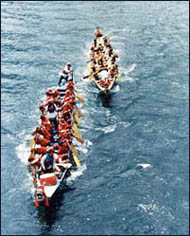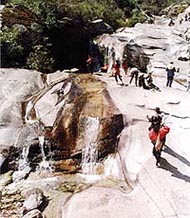Dali Travel Dali Tourism guide |
|
 |
The Pingyunnan Stele of Emperor Yuanshizu Dali
The Pingyunnan Stele of the Emperor Yuanshizu is in the center of March Street Square in the western part of the ancient City of Dayushi, at the foot of Zhonghe Peak in Cangshan Mountains. The stele was built in 1307, the 11th year of the reign of Yuan Dynasty Emperor Chengzhong. It is 4.44 meters high and 1.65 meters wide. It is made of two huge pieces of granite standing on the back of a stone turtle, hence its other name of Turtle Stele. It records how Yuan Emperor Khublai Khan pacified Yunnan and divided it into counties. Also it explains how Yunnan Province was established. |
|
Mansion of Du Wenxiu Dali
|
The mansion of Du Wenxiu is also known as the Forbidden City. It is inside the South Gate of ancient city of Dali. The mansion was built on the site of the former residence of the provincial military commander of the Qing Dynasty. The thick-walled mansion has carved eaves and yellow tiles. It has an earthen fortification, and this is why the mansion is also called the Forbidden City. It occupies an area of 55,000 square meters and is one kilometer in circumference. |
It is composed of the Wumen Gate, Front Hall, Main Hall, Tianzi Terrace, Main Palace, Side Halls, Rear Palace and Flower Hall. All the halls are magnificent, with painted and carved beams and eaves.
The Dehua Stele in Nanzhao Dali
The Dehua Stele in Nanzhao is at the foot of Fading Peak of Cangshan Mountains in the middle of Dali and Xiaguan and is six kilometers from Xiaguan City proper. It faces Erhai Lake, with its back to the Cangshan Mountains. The stele was built in 766, the first year of the reign of Tang Emperor Dehua. It is 3.02 meters high, 2.27 meters wide and 0.58 meter thick.
|
|
Made of sandstone, the stele records the political and military affairs of Nanzhao State and the cause of the Tianbao Battle between Nanzhao and Tang forces. Most important is the fact that the stele records Yunnan Province and the relations between these groups.
Tomb of Du Wenxiu Dali
|
The Tomb of Du Wenxiu is located in the eastern part of Xiadui Village, five kilometers southeast of Dali. Du Wenxiu was born in 1823, and died at the age of 49 in 1872. Du was a commander of a peasant uprising during the late Qing Dynasty, and established his power in Dali in September 1856.The uprising failed in November 1872, and Du was killed on December 26, 1872. His tomb was built in the sixth year of the Republic and was rebuilt in 1985. The tomb is 5.7 meters high and occupies an area of 4,340 square meters. |
The Grotto of the General Dali
The Grotto of the General, or the Temple of the General, is two kilometers northwest of Xiaguan, near Dali. It was built during the Ming Dynasty and occupies 0.67 hectare. It is composed of the Gate Tower, the Bazi Building and the Main Hall. The temple is now part of the Cangshan Park. It was built for the Tang Dynasty General Li Mi, who was sent to occupy Nanzhao in 754, or the 13th year of the reign of Tang Emperor Tianbao. |
|
The General drowned himself in a nearby river after his army was destroyed. A legend says that the local people built this temple to worship his stature.
The Dragon-tail City Dali
|
The Dragon-tail City was the southern gateway to the states of Nanzhao and Dali, on the northern reaches of the Erhe River in Xiaguan, Dali. According to the book history of Yunnan Province, "Dragon-tail City was built by Ge Luofeng, and extends several kilometers along the southern slopes of Cangshan Mountains. The city gate faces the Erhe River and a bridge over the river is 100 feet long."With Cangshan Mountains and Erhai Lake as natural barriers, the earthen city wall was built along Xieyang Peak and along the northern bank of the Erhe River as far as New Bridge. The city was a fortress protecting the capital of the states of Nanzhao and Dali. |
The Mirror Pavilion Dali
The Mirror Pavilion is at the southern end of Mount Yu'an on the east bank of Erhai Lake. It borders the ancient Luoquan Temple. The pavilion faces water on three sides and faces Jinsuo (Golden Shuttle) Island across the lake in the south. At the foot of the pavilion is the mirror-like water surface, reflecting the Cangshan Mountains, hence the name of the pavilion. The magnificent pavilion has been rebuilt, and is a famous scenic spot by Erhai Lake.
|
|
|
The Qingbi Stream in the Cang Mountains Dali
The Qingbi Stream is also named as the Green basin Water. The Qingbi Stream is located between the Shenying Peak and the Malong Peak of the Cang Mountains, which are located in the southwest of the ancient city of Dali, Yunnan Province. The mountain spring wells up just from the root of the rocks. It looks like gushing pearls and pouring jades in a shape of a big basin. There are 3 levels of the basin,
|
where the water is very clear and the stones are beautiful, making a unique combination of green and blue, so it was called Qingbi Stream. The Qingbi Stream is one of the top 18 streams in the Cang Mountains. The 3 pools of the Qingbi Stream are attracting innumerable tourists with its unique fascinations.
Ming's Xu Xiake climbed up the real world of the mountains in spite of all the dangers and sufferings and left behind him excellent diaries of his tour and poems for us. What the great painter Xu Beihong praised of the stream is that "No one of the peaks, gorges, forests and springs can's be expressed in the paintings", and regarded the appreciation of the scenes here as the utmost enjoyments of "the satisfaction of soul".
The Horse-washing Pond in the Cangshan Mountains Dali
The Horse-washing Pond lies between the Yuju and Zhonghe peaks in the Cangshan Mountains. It is 4,000 meters above sea level and is a high-latitude drift pond of the Quaternary Period. A legend says when Khublai Khan made an expedition to Dali, he crossed the Cangshan Mountains and washed his horses here. In late spring and early autumn, the weather is clear, the snow has melted and the flowers are blossoming. So both late spring and early autumn are the best seasons to visit the Horse-washing Pond. |
|
The Dragon-eye Cave Dali
|
The Dragon-eye Cave is on Piyu Cliff, located on the southern slope of Longquan Peak in the Cangshan Mountains, to the west of the ancient city of Dali. The towering cliff is like a rampant blue dragon. A path along the cliff leads to the Dragon-eye Cave at the top. By the mouth of the cave, there is a stone bridge called the Immortal Bridge. Across the bridge comes the Mouse Road, which leads to the Xuandi, Wendi and Yuhuang pavilions. |
The Cultural City of Nanzhao Dali
The Cultural City of Nanzhao is one kilometer to the southwest of the ancient city of Dali. This is a replica of a typical historical and cultural scene. Based on historical data and local history, some historical and cultural sites have been selected to represent the State of Nanzhao. The city is mainly composed of the Golden Hall, A Site for Sacred Music, Wax Statues, Nanzhao Cultural Street, Gardens, |
|
all reflecting the brilliant history and culture of the State of Nanzhao, including famous celebrities and the influence of Buddhism.
Houses of Bai Ethnic Group Dali
|
Houses of Bai Ethnic Group are made of earth and timber. The rooms are arranged along the east-west axis, and the front and rear yards are built along the south-north axis. The main gate is at the northeast corner. The main building stands in the west and faces east or stands in the east and faces west. The main building and the side buildings, a sitting room and a screen wall behind the gate constitute a closed courtyard. This is a typical residential house of the Bai ethnic group. A corridor leads to the main building, or there are buildings on three sides with a screen wall behind the gate or four groups of buildings with five courtyards. |
There are two kinds of gate tower. The residential houses of the Bai minority people demonstrate their long history and culture, and sophisticated architecture.
Snake-bone Tower Dali
Snake-bone Tower or Buddhist Picture Tower is on the east slope of Xieyang Peak of Cangshan Mountains, 11 kilometers south of ancient city of Dali, 800 meters right of the highway and three kilometers from Dali Citys proper. This hollow brick square tower is 30.7 meters high and has 13 eaves. Its architectural style is similar to that of the largest pagoda at Chongsheng Temple and was built in 836, the first year of the reign of the Tang Dynasty Emperor Kaicheng.
|
|
|
The Three Capitals Tour Dali
The three Capitals Tour was developed during the State of Nanzhao. At first, it was a Buddhist rite of the Bai ethnic group. Later, it developed into a spring outing. The "Three Capitals" refers to the Capital of Buddhism, the Capital of the Gods and the Capital of the Immortals. The Capital of Buddhism is the Chongsheng Temple, which is dedicated to Master Duan of the "Eight Classes of Brave Divine Beings".
|
The Capital of the Gods is the Shengyuan Temple at the foot of the Cangshan Mountains, which houses a statue of Duan Zongbang, the highest patron god. The Capital of the Immortals is the Jingui Temple in He'ai City to the east of Xizhou, in the garden of which Duan Zongbang used to play.
Dragon Boat Racing Dali
Dragon Boat Racing is one of the favorite sports of the Bai minority people living around Erhai Lake. Initiated in the time of the State of Nanzhao, during the Tang Dynasty, the races are held at the Torch Festival, on the 15th day of the sixth lunar month, each year. The races commemorate the sacrifice of the loyal wife of an ancient chieftain, who drowned herself in the lake.
The 7-dragon-girl Pool in the Cang Mountains of Dali
|
|
|
The 7-Dragon-Girl Pool is located on the Black Dragon Stream between the Dragon Spring and the Yuju Peak in the Cang Mountains of Dali, Yunnan Province. It become a rare scenic spot in the Cang Er Scenic Zone, due to its hanging rocks covering one on the another, its streams flowing into a waterfall and falling down into a pool. Going up along the streams, you can see the 7 Dragon-Girl Pools of the different natures lined one by one. The lowest one the No.1 Dragon-Girl Pool and the top one is the No.7 Dragon-Girl Pool. They are separated with an average distance between them of about 500 meters. While you are looking down from the top, |
you can hear the sound of the gushing springs which sounds like thunder, and you can enjoy a unique pleasure.
|
Main Cities in China Travel and China Hotels







 Beijing Beijing  Canton Canton
 Shanghai Shanghai  Hong
Kong Hong
Kong  Qingdao Qingdao  Hangzhou Hangzhou |
Other Major Cities:
Changchun,
Chengdu,
Chongqing,
Dalian,
Dongguan,
Dunhuang,
Foshan,
Guangzhou,
Guilin,
Haikou,
Harbin,
Hainan,
Hangzhou,
Kunming,
Lhasa,
Macau,
Nanjing,
Qingdao,
Sanya,
Shenyang,
Suzhou
Shanghai,
Shenzhen,
Tianjin,
Weihai,
Wenzhou,
Xiamen,
Xi'an,
Yiwu
|
Major China Hotels:
Beijing Hotels,
Chengdu Hotels,
Chongqing Hotels,
Dalian Hotels,
Foshan Hotels,
GuangZhou Hotels,
Guilin Hotels,
Hangzhou Hotels,
Harbin Hotels,
HongKong Hotels,
Kunming Hotels,
Macau Hotels,
Nanjing Hotels,
Qingdao Hotels,
Sanya Hotels,
Shanghai Hotels,
Shenyang Hotels,
Suzhou Hotels,
Tianjin Hotels,
Urumqi Hotels,
Wenzhou Hotels,
Xiamen Hotels,
Xian Hotels |
|
 |
|
